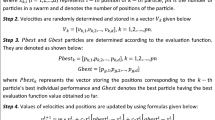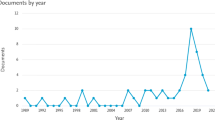Abstract
An economic-statistical design with multiple assignable causes following exponential distribution is presented in this paper for linear profiles. For this purpose, a tri-objective optimization model is proposed to minimize the cost with desired statistical performances. Average Run Length (ARL) as the primary statistical measure is employed for the appraisal of the designed linear profiles. The first objective to be minimized is a cost function that models the implementation cost in different states. The second objective is to maximize \({\text{ARL}}_{0}\) or the in-control average run-length of the monitoring scheme. The third objective to be minimized is \({\text{ARL}}_{1}\) or the out-of-control average run-length of the control chart. Besides, there are two constraints defined as the lower and the upper bounds on \({\text{ARL}}_{0}\) and \({\text{ARL}}_{1}\), respectively. This model optimizes the sample size, the sampling intervals, and related parameters for assignable causes concerning exponential distribution. As the problem is hard to solve analytically, a parameter-tuned meta-heuristic solution algorithm involving a multiple objective particle swarm optimization (MOPSO) alongside the response surface methodology (RSM) is employed to find a near-optimum solution. In this meta-heuristic, the response surface methodology is utilized to tune the parameters of the optimization problem. A numerical example is presented to illustrate the application of the proposed approach and assess its performance. Finally, sensitivity analyses of some parameters on the effects of the design parameters are performed. The results show the parameter profiling cost per set-points of a sample has the most effective implementation costs of linear profiles. Also, the proposed model is robust on some parameters such as the cost of identifying and modifying an assignable cause, fixed cost of sampling, and variable cost of the sampling process.


Similar content being viewed by others
References
Ahmadi-Javid A, Ebadi M (2021) Economic design of memory-type control charts: the fallacy of the formula proposed by Lorenzen and Vance (1986). Comput Stat 36(1):661–690
Ahmed I, Sultana I, Paul SK, Azeem A (2014) Performance evaluation of control chart for multiple assignable causes using genetic algorithm. Int J Adv Manuf Technol 70(9–12):1889–1902
Amiri A, Bashiri M, Maleki MR, Moghaddam AS (2014) Multi-objective Markov-based economic-statistical design of EWMA control chart using NSGA-II and MOGA algorithms. Int J Multicrit Decision Mak 4(4):332–347
Barzinpour F, Noorossana R, Niaki STA, Ershadi MJ (2013) A hybrid Nelder-Mead simplex and PSO approach on economic and economic-statistical designs of MEWMA control charts. Int J Adv Manuf Technol 65(9–12):1339–1348
Chen YS, Yang YM (2002) Economic design of x-control charts with Weibull in-control times when there are multiple assignable causes. Int J Prod Econ 77(1):17–23
Chung KJ (1994) An algorithm for computing the economically optimal X-control chart for a process with multiple assignable causes. Eur J Oper Res 72(2):350–363
Duncan AJ (1956) The economic design of X charts used to maintain current control of a process. J Am Stat Assoc 51(274):228–242
Ershadi MJ, Noorossana R, Niaki STA (2016) Economic design of phase II simple linear profiles with variable sample size. Int J Prod Quality Manag 18(4):537–555. https://doi.org/10.1504/IJPQM.2016.077781
Ershadi MM, Shams Shemirani H (2020) Simulation and optimization for improving performance of maintenance. Facilities. https://doi.org/10.1108/F-08-2019-0083
Fazelimoghadam M, Ershadi M, Akhavan Niaki S (2020) An efficient economic-statistical design of simple linear profiles using a hybrid approach of data envelopment analysis, Taguchi loss function, and MOPSO. J Optim Ind Eng 13(1):99–112. https://doi.org/10.22094/joie.2019.580054.1607
Gibra IN (1981) Economic design of attribute control charts for multiple assignable causes. J Qual Technol 13(2):93–99
Kang L, Albin SL (2000) On-line monitoring when the process yields a linear profile. J Qual Technol 32(4):418–426
Khanday MA, Singh JR (2020) Economic design of x̄ control chart under double EWMA. J Mod Appl Stat Methods 18(2):27
Khosravi P, Amiri A (2019) Self-Starting control charts for monitoring logistic regression profiles. Commun Stat Simul Comput 48(6):1860–1871
Kim K, Mahmoud MA, Woodall WH (2003) On the monitoring of linear profiles. J Qual Technol 35(3):317–328
Koohi I, Groza VZ (2014) Optimizing particle swarm optimization algorithm. In: 2014 IEEE 27th Canadian conference on electrical and computer engineering (CCECE). IEEE, pp 1–5. https://doi.org/10.1109/CCECE.2014.6901057.
Kumar S, Manjrekar V, Singh V, Lad BK (2020) Integrated yet distributed operations planning approach: a next generation manufacturing planning system. J Manuf Syst 54:103–122
Li Z, Wang Z (2010) An exponentially weighted moving average scheme with variable sampling intervals for monitoring linear profiles. Comput Ind Eng 59(4):630–637
Linderman K, Love TE (2000) Economic and economic statistical designs for MEWMA control charts. J Qual Technol 32(4):410–417
Lorenzen TJ, Vance LC (1986) The economic design of control charts: a unified approach. Technometrics 28:3–10
Malaki M, Akhavan NST, Ershadi MJ (2011) A comparative study of four evolutionary algorithms for economic and economic-statistical designs of MEWMA control charts
Mariel P, Hoyos D, Meyerhoff J, Czajkowski M, Dekker T, Glenk K et al (2021) Experimental design. In: Environmental valuation with discrete choice experiments. Springer, Cham, pp 37–49. https://doi.org/10.1007/978-3-030-62669-3_3.
Montgomery DC (2017) Design and analysis of experiments. Wiley
Nassar SH, Abdel-Salam ASG (2021) Semiparametric MEWMA for Phase II profile monitoring. Qual Reliab Eng Int. https://doi.org/10.1002/qre.2829
Nenes G, Tasias KA, Celano G (2015) A general model for the economic-statistical design of adaptive control charts for processes subject to multiple assignable causes. Int J Prod Res 53(7):2146–2164
Noorossana R, Amiri A, Vaghefi A, Roghanian E (2004) Monitoring quality characteristics using linear profile. In: Proceedings of the 3rd international industrial engineering conference, pp 246–255. https://www.civilica.com/Paper-IIEC03-IIEC03_022.html
Noorossana R, Niaki STA, Ershadi MJ (2014) Economic and economic-statistical designs of phase II profile monitoring. Qual Reliab Eng Int 30(5):645–655
Piri S, Abdel-Salam ASG, Boone EL (2021) A wavelet approach for profile monitoring of Poisson distribution with application. Commun Stat Simul Comput 50(2):525–536
Roshanbin N, Ershadi MJ, Niaki STA (2019) Multi-objective economic-statistical design of simple linear profiles using a combination of NSGA-II, RSM, and TOPSIS. Commun Stat Simul Comput. https://doi.org/10.1080/03610918.2019.1680692
Salmasnia A, Abdzadeh B, Namdar M (2017) A joint design of production run length, maintenance policy and control chart with multiple assignable causes. J Manuf Syst 42:44–56
Song Z, Mukherjee A, Zhang J (2021) Some robust approaches based on copula for monitoring bivariate processes and component-wise assessment. Eur J Oper Res 289(1):177–196
Tasias KA, Nenes G (2019) Monitoring location and scale of multivariate processes subject to a multiplicity of assignable causes. Quality Technol Quant Manag 1–17
Koo T-Y, Case KE (1990) Economic design of X-bar control charts for use in monitoring continuous flow processes. Int J Prod Res 28(11):2001–2011. https://doi.org/10.1080/00207549008942848
Vaghefi A, Tajbakhsh SD, Noorossana R (2009) Phase II monitoring of nonlinear profiles. Commun Stat Theory Methods 38(11):1834–1851
Walker E, Wright SP (2002) Comparing curves using additive models. J Qual Technol 34(1):118–129
Wang J, Ma X, Xu Z, Zhan J (2021) Three-way multi-attribute decision making under hesitant fuzzy environments. Inf Sci 552:328–351
Xue Y, Tang T, Pang W, Liu AX (2020) Self-adaptive parameter and strategy based particle swarm optimization for large-scale feature selection problems with multiple classifiers. Appl Soft Comput 88:106031
Xue Y, Xue B, Zhang M (2019) Self-adaptive particle swarm optimization for large-scale feature selection in classification. ACM Trans Knowl Discov Data (TKDD) 13(5):1–27
Yang WA, Guo Y, Liao W (2012) Economic and statistical design of X-bar and S control charts using an improved multi-objective particle swarm optimisation algorithm. Int J Prod Res 50(1):97–117
Yang YM, Su CY, Pearn WL (2010) Economic design of x¯-control charts for continuous flow process with multiple assignable causes. Int J Prod Econ 128(1):110–117
Ye J, Zhan J, Ding W, Fujita H (2021) A novel fuzzy rough set model with fuzzy neighborhood operators. Inf Sci 544:266–297
Ye J, Zhan J, Xu Z (2020) A novel decision-making approach based on three-way decisions in fuzzy information systems. Inf Sci 541:362–390
Yu FJ, Hou JL (2006) Optimization of design parameters for control charts with multiple assignable causes. J Appl Stat 33(3):279–290
Zhan J, Jiang H, Yao Y (2020) Three-way multi-attribute decision-making based on outranking relations. IEEE Trans Fuzzy Syst. https://doi.org/10.1109/TFUZZ.2020.3007423
Zhang K, Zhan J, Wu WZ (2020) On multi-criteria decision-making method based on a fuzzy rough set model with fuzzy α-neighborhoods. IEEE Trans Fuzzy Syst. https://doi.org/10.1109/TFUZZ.2020.3001670
Funding
All authors declare that for this paper, there is no any fund to support it financially. No funding was received.
Author information
Authors and Affiliations
Corresponding author
Ethics declarations
Conflict of interest
There is not any conflict of interest to declare by the authors.
Human and animals rights
This article does not contain any studies with human or animals participants performed by any of the authors.
Informed consent
Informed consent was obtained from all individual participants included in the study. This statement is to certify that all authors have seen and approved the manuscript being submitted in Soft Computing journal. We warrant that the article is the authors’ original work. We warrant that the article has not received prior publication and is not under consideration for publication elsewhere. On behalf of all co-authors, the corresponding author shall bear full responsibility for the submission. This research has not been submitted for publication nor has it been published in whole or in part elsewhere. All authors agree that author list is correct in its content and order.
Additional information
Publisher's Note
Springer Nature remains neutral with regard to jurisdictional claims in published maps and institutional affiliations.
Rights and permissions
About this article
Cite this article
Ershadi, M.J., Ershadi, M.M., Haghighi Naeini, S. et al. An economic-statistical design of simple linear profiles with multiple assignable causes using a combination of MOPSO and RSM. Soft Comput 25, 11087–11100 (2021). https://doi.org/10.1007/s00500-021-05854-7
Accepted:
Published:
Issue Date:
DOI: https://doi.org/10.1007/s00500-021-05854-7




